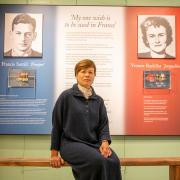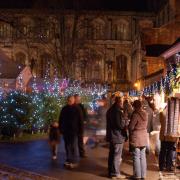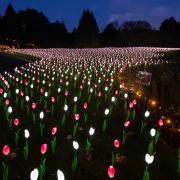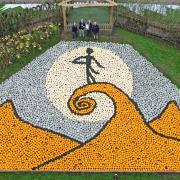Discover the great outdoors throughout the year with our selection of nature reserves located across Hampshire.

Roydon Woods Nature Reserve
Set within the New Forest National Park, this extensive 400-hectare reserve is home to many animals typical of the New Forest, including badger, deer, owls and bats. As well as woodland, there is heathland, grassland and meadows all managed with ponies and cattle, therefore rich in wildlife.
In late spring and early summer butterflies use the woodland clearings and areas of bracken to feed on the flowers of bugle and self-heal.
On ‘The Commons’ on a warm day, the beautiful demoiselle damselfly is on the wing and reptiles bask on the bare ground between the heather. Look for round-leaved sundew, which feeds on small insects trapped by the sticky hairs on its leaves. This unusual plant can live up to 50 years! As dusk falls, if you are walking through the heath and grass areas, listen for nightjar and owls. You are likely to see bats and badgers too.
Explore the woods when they are ablaze with the fiery reds and oranges of autumn. Pushing their way up through the leaf litter, on trees or fallen wood, are fungi of all shapes, sizes and colours, including the delicate porcelain fungus. In October on an early morning walk, listen out for fallow and sika deer rutting (males fighting for mates) - but do not get too close. All year round you are likely to encounter roaming herds of deer.

By winter, stripped of their greenery, the mature oak and beech trees reveal a marvellous array of lichens - over 150 different species have been recorded here, including some rarities.
Testwood Lakes Nature Reserve
Standing beside these scenic lakes bustling with birdlife, it’s hard to imagine that this reserve was once an industrial site used for extracting gravel. Today, Testwood’s meadows, woodlands and lakes are home to a wide range of plants and animals, all of which can be enjoyed from a network of surfaced paths.
From the hides in spring, enjoy views of breeding lapwing and oystercatcher and parent birds feeding their well-camouflaged chicks.
On all three lakes you can see the dramatic courtship dance of great crested grebe. By summer black and white striped chicks are hitching a ride on their parents’ backs across the water. Watch the sand martins’ aerial displays as they dip in and out of their artificial nest bank to feed young.

Take the boardwalk that meanders through bluebells, huge alder trees and ancient ferns in ‘Alder Gully’, which is always alive with bird song.
In spring the pretty blooms of cuckooflower attract the orange-tip butterfly. In summer next to the centre, the wildflower meadow is ablaze with purple knapweed and vivid bird’s-foot trefoil. On warm days look for striking dragonflies such as emperor, four-spot chaser and southern hawker, as well as the more delicate banded damselfly and beautiful demoiselle.
In winter enjoy the views across Meadow Lake and the scrapes when flocks of lapwing join wildfowl such as teal and wigeon to rest and feed here.
Pamber Forest Nature Reserve
With over 200 hectares of woodland and many paths and tracks that weave between the trees, this is a place for exploration and return visits. From the tallest oak to the smallest moss, the wildlife is ever-changing with the changing seasons.

In early spring enjoy the pretty violets and primroses - these native woodland flowers are the positive result of coppicing the woodland, to allow more light to reach the woodland floor. Beneath the dense tree canopy a wealth of shade-loving plants brightens the woodland floor, including Soloman’s-seal, tutsan and wood spurge.
In summer wild honeysuckle and bramble flowers perfume the wide, sunlit rides. Flowers including betony, bitter vetch, golden rod and bilberry line the route too. Making use of this woodland banquet are handsome white admiral and silver-washed fritillary butterflies. High up in the tree tops you may hear blackcap, while in the open grass and heath, green woodpecker are often heard.
The ‘Donkey Tree’ - over 300 years old, this is the oldest tree in Pamber Forest. Local legend has it that a man once hung his donkey from this tree when it refused to go any further.
Farlington Marshes Nature Reserve
A coastal wildlife expanse with internationally important populations of wading birds and wildfowl. Though not far from Portsmouth, you can escape the bustle of everyday life, as you walk along the sea wall footpath with stunning views inland of the reserve and across Langstone Harbour.
In spring listen for the ‘pee wit’ call of lapwing and the uplifting song of the skylark as they perform acrobatic displays over the marshes to impress potential mates. Look for wildflowers, such as corky-fruited water dropwort, yellow rattle and southern marsh-orchid.
Salt marsh plants include the colourful glasswort that gradually turns from green to pinks, purples and browns. At high tide waders come in to roost in the lake, after feeding in the harbour. On a warm summer day watch brightly coloured dragonflies, such as broad-bodied chaser, emperor and migrant hawker.
The number and variety of waders and wildfowl reach their highest peak during the autumn migration, including black-tailed godwits, redshank, grey plover and greenshank.
In winter it’s well worth wrapping up to watch thousands of dark-bellied brent geese feeding on the grass in the marshes. Out over ‘The Deeps’ impressive numbers of teal, wigeon, pintail and shoveler can be seen.
This is a great reserve for raptor-watching: peregrines all year, osprey, hobby and red kites in summer, merlin, marsh harrier and short-eared owl in winter.
Blashford Lakes Nature Reserve
Created from flooded gravel pits used for drinking water storage, Blashford Lakes is now a bustling centre of activity for both wildlife and people. Thousands of birds use this site all year round, and with many hides, this is a great destination to bring your family for a wildlife walk, whatever the weather or time of year.
Enjoy the unique mix of water habitats across this 200ha reserve, including spectacular views across Ibsley water. Beside the clear, shallow Dockens Water you may see a kingfisher or roe deer. In summer watch the aerial acrobatics of many dragonflies and damselflies, including the downy emerald.
The woods hold year-round interest, including primrose and wild daffodil in spring, warblers in the summer and fungi in autumn. Step inside our woodland hide for close-up views of great tit, chaffinch and the great spotted woodpecker feeding on nuts and seeds.
In winter up to 5,000 wildfowl flock to the lakes including gadwall, goldeneye and goosander.



























